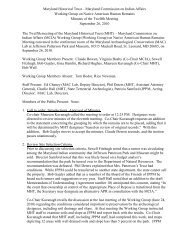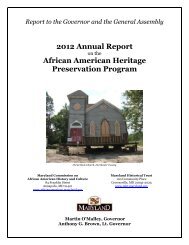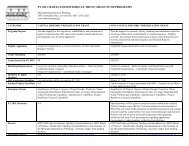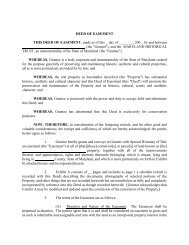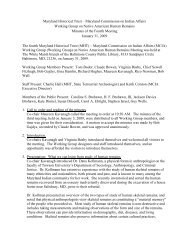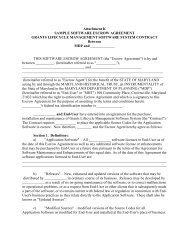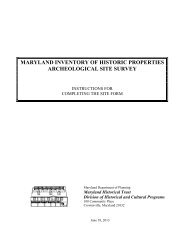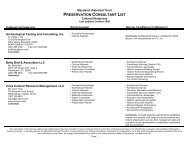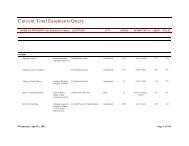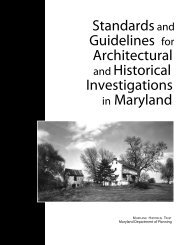<strong>The</strong> <strong>Maryland</strong> <strong>Preservation</strong> <strong>Plan</strong>, <strong>2005</strong>Objective 3: Improve the techniques, treatments and toolsavailable to local governments for heritage preservation andcommunity conservation efforts.GOAL 5: SECURE THE TECHNOLOGICAL, FINANCIAL AND LEGAL TOOLSSUFFICIENT TO PRESERVE MARYLAND'S HERITAGE RESOURCESObjective 1: Use available technology to increase thecollection, maintenance and dissemination of heritage resourceinformation.Objective 2: Ensure that investments to enhance and sustainheritage resources are leveraged through easily accessiblepublic incentives.Objective 3: Eliminate disincentives to the enhancement andsustainability of heritage resources.A. Growth Management and Neighborhood RevitalizationInvigorating communities through revitalization projects that are sensitiveto <strong>Maryland</strong>'s rich history and culture is a central policy of <strong>Maryland</strong> Stategovernment. Implementing effective growth management strategies whileencouraging economic development is a priority, and State policies and grantprograms are targeted accordingly.With the overall population predicted to rise from 5,296,486 in 2000 to6,446,400 in 2030, all State agencies have begun to prepare for the anticipatedincrease in demand for more infrastructure, better schools, more housingoptions, and adequate transportation routes. In the past, population growth andits related infrastructure demands have contributed to sprawling urbanization,overtaxed road systems, piecemeal residential development in rural areas, andoverextended and under-funded infrastructure systems. Today, the State isworking towards mitigating the impact of such undesirable effects of growth bydirecting development towards already established communities.One of the ways in which the State is implementing this directed growthpolicy is by focusing State dollars to priority funding areas in established communitiesand locally-determined growth areas. Under the <strong>Plan</strong>ning Act of 1992,local jurisdictions are required to prepare comprehensive plans. State fundedpublic works, transportation, and capital improvement projects must be consistentwith the State's Economic Growth, Resource Protection, and <strong>Plan</strong>ningPolicy and the Comprehensive <strong>Plan</strong> of the jurisdiction in which the project islocated. By giving priority funding to those areas within local jurisdictions thathave existing or planned development infrastructure, the State is supportingefficient and economical growth while combating sprawl and its resultantconsequences - the loss of fields, farms, and neighborhoods. Through the localzoning and capital planning process, local jurisdictions determine which areasqualify as priority funding areas or “designated revitalization areas.” <strong>The</strong>se6
Statewide Priorities for Heritage Resource Conservationpriority when vying for State funding for roads and highways, business developmentfinancing and economic development, and most housing programs.Almost all of <strong>Maryland</strong>’s many historic communities contain under- orunused historic buildings that could be renovated to provide housing andbusiness locations for new residents and business-owners. In fact, 85% of<strong>Maryland</strong>’s inventoried historic properties are located in the State’s incorporatedcities and towns. Notably, the repair and improvement of infrastructure inthese areas is less costly than the construction or extension of new infrastructureto scattered rural developments. By directing growth back to establishedcommunities that provide both a variety of housing options and an adequateinfrastructure investment, important agricultural and scenic properties will beprotected for the enjoyment of future generations.B. Economic Development and Heritage TourismEssential to the State’s well-being in the twenty-first century is itssustained economic vitality. While some communities are currently facing a risein population and with it an increasing demand for employment opportunitiesand services, others must address the result of decreasing investment and outmigration.Economic development is a priority shared by both public agencies andprivate organizations. Both have developed programs to assist commercialenterprise. <strong>The</strong> Main Street <strong>Maryland</strong> Program, operated out of the <strong>Maryland</strong>Department of Housing and Community Development, offers technical assistanceaimed at improving the economy, appearance, and image of traditionaldowntown business districts. <strong>The</strong> <strong>Maryland</strong> Department of Business andEconomic Development (DBED) and its Office of Tourism Development workto attract new businesses and visitors to the State. <strong>The</strong>se programs capitalizeon local heritage preservation efforts.One of the methods by which the State hopes to increase revenues isthrough the development of heritage tourism. <strong>The</strong> wide array of historic communities,historical and cultural museums, and scenic and natural resources thatabound in <strong>Maryland</strong> are assets that can contribute to economic well-being ofMARYLAND’S POPULATION GROWTH1980 - 2030<strong>Maryland</strong>’s populationhas increased steadilyand rapidly in recentdecades, and projectionsindicate thegrowth trend will continue.1980 2000 2015 2030MARYLAND 4,216,933 5,296,486 6,060,800 6,446,400Baltimore Region 2,173,989 2,512,431 2,764,350 2,847,550Lower Eastern Shore 145,240 186,608 214,000 230,200Southern <strong>Maryland</strong> 167,284 281,320 375,050 442,300Upper Eastern Shore 151,380 209,295 253,350 278,450Washington Suburban 1,358,916 1,870,133 2,201,250 2,385,950Western <strong>Maryland</strong> 220,124 236,699 252,800 261,950Figures prepared by the <strong>Maryland</strong> Department of <strong>Plan</strong>ning, <strong>Plan</strong>ning Data Services, May 2004.7
- Page 1 and 2: THE MARYLANDPRESERVATION PLAN2005
- Page 3 and 4: THE MARYLAND HISTORICPRESERVATION P
- Page 6 and 7: The Maryland Preservation Plan, 200
- Page 8 and 9: The Maryland Preservation Plan, 200
- Page 12 and 13: The Maryland Preservation Plan, 200
- Page 14 and 15: The Maryland Preservation Plan, 200
- Page 16 and 17: The Maryland Preservation Plan, 200
- Page 18 and 19: The Maryland Preservation Plan, 200
- Page 20 and 21: The Maryland Preservation Plan, 200
- Page 22 and 23: The Maryland Preservation Plan, 200
- Page 24: The Maryland Preservation Plan, 200
- Page 27 and 28: The Status of Heritage ResourcesGOA
- Page 29 and 30: The Status of Heritage Resources•
- Page 31 and 32: Suggestions for Implementing Statew
- Page 33 and 34: Suggestions for Implementing Statew
- Page 35 and 36: Selected Bibliographyagricultural a
- Page 37 and 38: Statewide Historic Contextszoos, an
- Page 39 and 40: Statewide Historic ContextsAmerican
- Page 41 and 42: Partners in Statewide Heritage Cons
- Page 43 and 44: Cover photo is courtesy of Tom Dard



